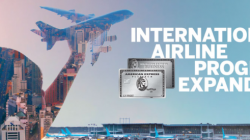Because elite status is so critical to making air travel enjoyable, not just on mileage runs but on mandatory vacation/business trips, too, I think it is worth spending some time discussing how to choose an airline loyalty program with which you will accrue that status. However, I won’t be spending too much time on the actual benefits of elite status. This is partly because the benefits of lower tiers just aren’t as distinct as they used to be. In the past I would have told just about anyone to go for United’s MileagePlus program because even members at the lowest tier had complimentary EconomyPlus seating at booking (a HUGE plus for international trips) and two free checked bags. Now that’s been diluted to one free bag and EconomyPlus can’t be selected until check-in, and other carriers like Delta are starting to introduce extra legroom seats on international flights.
Another reason I don’t want to spend too much time on this topic is that The Points Guy has already done a thorough comparison of all the elite status tiers on the four major domestic carriers: United/Continental, American, Delta, and US Airways.
- The Points Guy: Comparing low-tier status
- The Points Guy: Comparing mid-tier status
- The Points Guy: Comparing top-tier status
Understanding and being able to actually use the benefits of your status is very important, so I suggest you read his posts. They go into more detail than I want to discuss today, though I might come back to it later. Instead, I want to talk about all the other factors of choosing an airline, factors that I think may actually be more important than the differences in things like how upgrades clear or whether you can extend your benefits to a companion.
Brian also has some posts on how to find mileage runs and why mileage running is worthwhile that he published as part of the same series, but I’m not quite as impressed since I think I have done a more thorough walkthrough of ITA’s features and believe he overestimates the value of elite status. There are also more advanced ways to mileage run besides using ITA. So I will spend my time trying to focus on those areas in the weeks ahead.
Comparing Domestic Route Networks
It’s most important to me that I be able get where I want to go whether I’m paying or using miles. It’s probably important to you, too, so think about the kinds of places you’d like to visit. I grew up near San Francisco, went to college and have friends near Los Angeles, worked for a time in Washington (where I have more friends), and am now dating someone from Amarillo, Texas. We both have friends in New York. So I visit or transit the SFO, LAX, DEN, IAH, EWR, and IAD hubs of United on almost every trip. The only hub I haven’t been to is Cleveland (and Guam, if you count that).
American Airlines and Delta Air Lines are the two other carriers with large domestic route networks. However, American is particularly focused on the domestic market, with a weak international route network. Because I want to travel internationally, the benefits of elite status are going to be somewhat less if I am forced to travel on an alliance carrier instead of on American itself. Delta doesn’t have quite the same problem, but they are weaker on the West Coast, particularly the Pacific Northwest, so that isn’t going to work for me.
Maybe Alaska Airlines works for most people in the Seattle area, but I don’t particularly want to live here after I graduate. Even if I have the benefit of nonstop flights right now, that’s not necessarily a good thing because it means fewer miles. My status and miles could also be worth much less after I move. However, although Alaska isn’t part of a worldwide alliance just yet, it has many less official partnerships and is a good place to credit miles from airlines like American that I travel with infrequently.
Finally, the low-cost carriers like Southwest, JetBlue, and Virgin America are all still in various stages of expansion. I’m lumping US Airways in this group, too. Southwest has the better route network, but it’s not as good on the East Coast (maybe that will change following the completed merger with AirTran) and the lack of a well-defined hub-and-spoke system frustrates me. Why am I connecting in San Jose and Las Vegas to get to Amarillo? JetBlue doesn’t even fly to Amarillo. You can see we all have our deal breakers. 😉 And Virgin America flys to even fewer destinations, especially on the East Coast. US Airways may partner with United, giving me some shared benefits if i had to fly United for certain trips, but their focus is also on the East Coast.
Comparing International Route Networks
Do you have an interest in traveling to Europe and Asia? Then United is probably the carrier for you. They have a strong presence in the Pacific, the merger with Continental expanded their presence in Europe, and they are part of the Star Alliance with several excellent carriers on both continents (Lufthansa, Swiss, ANA, Thai, and Singapore are just a few). Delta’s affiliation with SkyTeam members like KLM-Air France, and American’s affiliation with British Airways also provide good reach to Europe, but with some variation. For example, You can’t get from the U.S. to Paris on a direct flight from the West Coast, and even if you do connect in someplace like Washington-Dulles, you may be flying to Paris on a Boeing 757, a narrow-body plane that is stretched to its operating limit on that route. Exotic locales like the Maldives may also be easier to access through particular alliances since they have fewer carriers serving them.
US Airways has access to the same Star Alliance partners as United, but their own international network and their planes are nowhere close. They also make it difficult to redeem award miles since they require roundtrip awards, though they do have discounts on award tickets during off-peak times. Generally I see United as my primary airline for actual flying and earning status, but I pay attention to US Airways’ promotions since they can be a good way to earn and spend miles cheaply.
Comparing Service Levels
Finally, even if the benefits and the route networks are the same, all airlines have differences in the service they provide. A lot of this is subjective and dependent on your status. For example, one of the concerns surrounding the United-Continental merger was that United had a reputation for treating its elites like kings (and its non-elites like, well… you get the idea) and Continental provided very even service quality, effectively dumbing down what elites received and raising standards for non-elites. Compensation for dissatisfied passengers or volunteering your seat on a United plane was particularly generous compared to Continental’s tight-fisted approach. Of course, Continental probably had the better policies from a business perspective, but United travelers were justifiably worried about their benefits being reduced.
Seat quality and aircraft type are very much personal preferences. I enjoy the Economy Plus seats on United and am glad to see they are being extended to Continental’s fleet. However, I think Continental has less comfortable seats on their planes in both first and coach cabins. The increasing use of regional jets on some United flights also worries me, particularly on routes like SEA-LAX (~1,000 miles each way) and SEA-SFO (~650 miles, though most flights are still operated by mainline aircraft). It pays to know the features of your preferred aircraft and how you can make the best of a bad situation. United’s Bombardier CR-700 regional jets have a (small) first class cabin and are reasonably spacious in coach, but the Embraer ERJ-145 that I often have to fly to Amarillo is uncomfortable even in the exit row. I frequently choose my flights to SFO based not on departure time but on whether it is operated by a CR7, Airbus 319, Airbus 320, or Boeing 757 because each has a different ratio of first class seats that will affect my chances at an upgrade.
There is not much difference left when it comes to food in coach, though it may be worth checking out the buy-on-board options. United has received particular praise for its tapas box, and American just announced that it will be serving complimentary beer and wine on international flights (a feature that has been on international carriers for years). But choices are more noticeable in the first class cabin, and if you have top-tier status that is where you will be more often than not. I was long envious of the ice cream sundaes that American served, and they also continued offering hot nuts after United discontinued the practice, replacing them with ice cold nuts in a foil pouch, bringing first class down to coach standards.
But now United has announced it will be bringing back hot nuts and will begin offering ice cream sundaes. Joy of joys! 😀 I also appreciate that the Continental side of the merger is brining with it pre-mixed margaritas and arguably better and more substantial food. Shorter flights may not have meal service anymore (I remember having salmon on LAX-SEA once), but the snack basket has some tasty options like Toblerone bars, Pop Chips, bananas, and almonds.
Most newer Continental planes also have individual DirecTV systems at every seat, and there are plans to extend something like this across the fleet. American provides premium cabin customers with Samsung Galaxy Tabs on some flights. In contrast, United and Continental are severely lacking when it comes to WiFi access. Choose Delta or American for that (US Airways only offers it on newer Airbus 321 aircraft), but United claims it is making this a priority.
Summary
As you can see, a lot of this comes down to where you fly and what you value. Are you a domestic traveler who only flies short trips under 2,000 miles between secondary airports? You are probably going to have very different needs and desires from someone like me. I encourage you to sit down, list your travel for the coming year, and think carefully about what you want from an airline. Like marriage, a loyalty program is something that could follow you through life and significantly affect your travel decisions and travel experiences. Don’t rush into one without considering the benefits and costs.
Readers, what are your favorite loyalty programs, and why do you stick with them? Are there any of you who wish you’d made a different choice but feel locked in because of the status or miles you’ve already earned?




